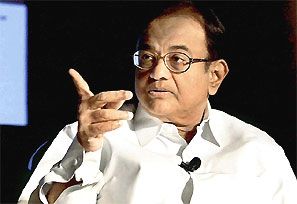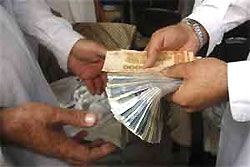 | « Back to article | Print this article |
A theory that is doing the rounds is that with election nearing, this depreciation of the rupee will allow politicians of all hues to bring back their ill-gotten wealth.
Speaking at an award function in Chennai a few weeks back to honour excellence in financial journalism, the Hon’ble Finance Minister Mr. P Chidambaram frowned on the titillating language used by sections of the media, especially in the world of finance.
As a case in point the FM referred to the oft-repeated headlines of “Rupee Plunges” even as our currency would have depreciated by a few Paise against the US dollar. Pointing to the fact that only bungee jumpers plunge, the FM reiterated, the rupee never plunged.
 That, to me, seemed ominous. The reason for the same is not far to seek for whenever any FM, especially the present incumbent opines on the state of the economy, it is a remarkable coincidence that Indian economy faces significant turbulence! The joke in Dalal Street is that whenever the FM bats for the markets the Sensex loses a few hundred points.
That, to me, seemed ominous. The reason for the same is not far to seek for whenever any FM, especially the present incumbent opines on the state of the economy, it is a remarkable coincidence that Indian economy faces significant turbulence! The joke in Dalal Street is that whenever the FM bats for the markets the Sensex loses a few hundred points.
Interestingly, even as the FM had claimed a fortnight ago that the Indian economy is witnessing copious flows of foreign investment, the rupee came under severe strain.
What the FM failed to mention is that the rupee has depreciated by approximately 7.5 per cent this year. But so have several currencies across continents. That includes Indonesian Ruphiah (4.5%), Brazilian Real (4.7%), Philippine Peso (5.5%), Turkish Lira (6.1%), Korean Won (6.2%), Russian Ruble (6.9%) and South African Rand (17.2%) - (Source: The Hindu Business Line – June 21, 2013)
Obviously, when compared to its peers, the Rupee has not performed badly.
However, none from our establishment could put his finger on one precise reason for this depreciation till date. Nevertheless, the fact of the matter is that the Indian Rupee is under pressure on account of a variety of reasons.
Gold - the Gorilla in the room?
And at the core of the issue is the current account deficit [explained as imports over exports leading to a deficit] that makes India vulnerable to external shocks. And as one looks at the basket of goods imported, economists within the establishment somewhere down the line hold surging gold imports as the villain of the piece.
Professor R Vaidyanathan of Indian Institute of Management, Bangalore puts the matter rather humorously when he says that even as such lecturing goes on by sarkari experts, ladies in their own household would well be shopping for gold! And that would include the FM's household too.
 What else would explain the sudden spurt in gold imports to about 150 tons per month on an average in the first two months of this fiscal when was 75 tons per month the previous fiscal?
What else would explain the sudden spurt in gold imports to about 150 tons per month on an average in the first two months of this fiscal when was 75 tons per month the previous fiscal?
Surely this near doubling of gold imports in recent months despite the sharp fall in international prices has flummoxed our economists who expected Indians to refrain from purchasing gold even as renowned international experts predicted its collapse. Even as the lady in every Indian household sees this drop in gold prices as value purchase, our economists fail to do so!
But our economists have a point. Year on year we as Indians do buy huge quantities of gold. For 2012-13 our gold import bill was $55 billions. This import creates huge pressure on the rupee as it converts precious foreign currency into gold. Crucially, it is actually unproductive from an economist’s standpoint. Significantly, gold purchases are usually sourced through unaccounted income.
In the process, the government suffers from a double whammy. First gold import causes current account deficits and secondly, it is the cause and consequence of proliferation of unaccounted money within the national economy. Surely it is a gorilla in the room. But yet to this date the Indian establishment would offer nothing concrete except to wish it away!
Lack of avenues
There is yet another dimension to this discussion. Thanks to demographic dividend and lack of state sponsored social security, savings rate is one of the highest in the world. But thanks to this failure of the government, there are very little avenues to invest our savings within India with scope for assured yet reasonable returns. Let me elaborate.
Surely capital market is one investment avenue. But despite the hoopla surrounding the same, (one is astounded by the fact that channels are run exclusively for this) the fact remains Rs 5,904 crore (Rs 59.04 billion) got invested in IPOs in 2011-12 and Rs 6,043 crore (Rs 60.43 billion) in the first nine months of the fiscal 2012-13. (Source: Economic Survey 2012-13 Page 120)
What may be interesting to note is that shares and debentures accounted for 8.3 per cent of total financial savings in the1980s; their share increased to nearly 13 per cent in the 1990s before declining to 4.8 per cent in the 2000s
 And this pattern extends to whole of financial sector. Thanks to successive scams, the average Indian investor is completely cynical about this sector and its functioning. It is in this connection I must confess that even as a chartered accountant I have very little faith in the system of accounts, accounting standards and audits not to speak of regulators like Institute of Chartered Accountants of India, IRDA, RBI, PFRDA and SEBI.
And this pattern extends to whole of financial sector. Thanks to successive scams, the average Indian investor is completely cynical about this sector and its functioning. It is in this connection I must confess that even as a chartered accountant I have very little faith in the system of accounts, accounting standards and audits not to speak of regulators like Institute of Chartered Accountants of India, IRDA, RBI, PFRDA and SEBI.
That explains why financial sector reforms in India are completely irrelevant. Interestingly, as the government clamours for more financial sector reforms the Indian households have been extremely chary of the same. What else would explain the decline of the share of financial savings vis-à-vis physical savings in recent years?
Financial savings, it may be noted take the form of bank deposits, life insurance funds, pension and provident funds besides investment in capital markets. Interestingly, financial savings accounted for around 55 per cent of total household savings during the 1990s. This declined to 47 per cent in the previous decade and it was a mere 36 per cent in 2011-12.
Of course, investment into bank deposits has been another traditional avenue. But thanks to the myopic policy of the UPA Government and mispricing of the interest rate regime for the past few years, Indians have been shying away from investing even into Banks.
In fact, household financial savings were lower by nearly Rs 90,000 crore (Rs 900 billion) in 2011-12 vis-à-vis 2010-11 (Source: Economic Survey 2012-13 Page 15). And it is this money that gets invested as gold and real estate - assets that economists within the establishment term as unproductive yet found lucrative by the ordinary Indians! Paradoxical isn’t it?
How about governance?
There is another interesting facet to this discussion. Thanks to a decade of mis-governance and policy paralysis at the Centre, production of even ordinary items has been stymied within India. That has compelled Indians to import when these items could be ordinarily produced or manufactured in India.
In this connection it is pertinent to note that in 2011-12, we imported Rs 100,911 crore (say $20 billion) of “sensitive” items as compared to Rs 70,656 crore (Rs 706.56 billion) in 2010-11 - a spectacular rise of 43 per cent! Remember, this includes mundane items like milk and milk products, fruits, vegetables, pulses, edible oils, rubber, spices, toys and other sundry items that could easily be produced or manufactured in India.
If such items are imported why complain about gold? Remember that we import approximately 80 per cent of our crude requirements - the big daddy of them all.
Th ere is yet another disturbing piece of information - our trade with China. For the first nine months (April-December 2012) of the previous fiscal, imports from China exceeded $42 billion while exports were a mere $10 billion. This implies a huge trade gap in excess of $40 billion for the entire year.
ere is yet another disturbing piece of information - our trade with China. For the first nine months (April-December 2012) of the previous fiscal, imports from China exceeded $42 billion while exports were a mere $10 billion. This implies a huge trade gap in excess of $40 billion for the entire year.
While an average Indian household may now know the complete details of all these, surely they appreciate that a current account deficit in excess of five per cent is unsustainable for India. That implies that we require capital flow in excess of $100 billion to fund this deficit - surely an unsustainable proposition.
In the process let us not forget, investment is a function of confidence. And as I have always held, foreign investment follows domestic investment. Where is the question of foreign investment when domestic investors are rushing to park their money in gold?
More importantly, as India continues to maintain gargantuan current deficit - buying gold becomes a self fulfilling prophecy - a situation where the investor is rewarded simply by depreciating rupee. This depreciation (coupled with increased levy of taxes) virtually turns gold into a risk free investment as it more than compensates for the fall of international gold prices.
Put pithily an average Indian has ultimately turned out to be much smarter than the collective intelligence of our establishment and its ability to deliver. By simply refusing to invest in financial products Indians seem to be rewarded. In this two way bet – one on gold and another on the foolishness of the government – the average Indian seems to have triumphed.
PS: Another theory doing rounds is that election is nearing. This depreciation of the rupee allows politicians of all hues to bring back their ill-gotten wealth.
The author is a Chennai based Chartered Accountant. Comments can be sent to mrv@mrv.net.in